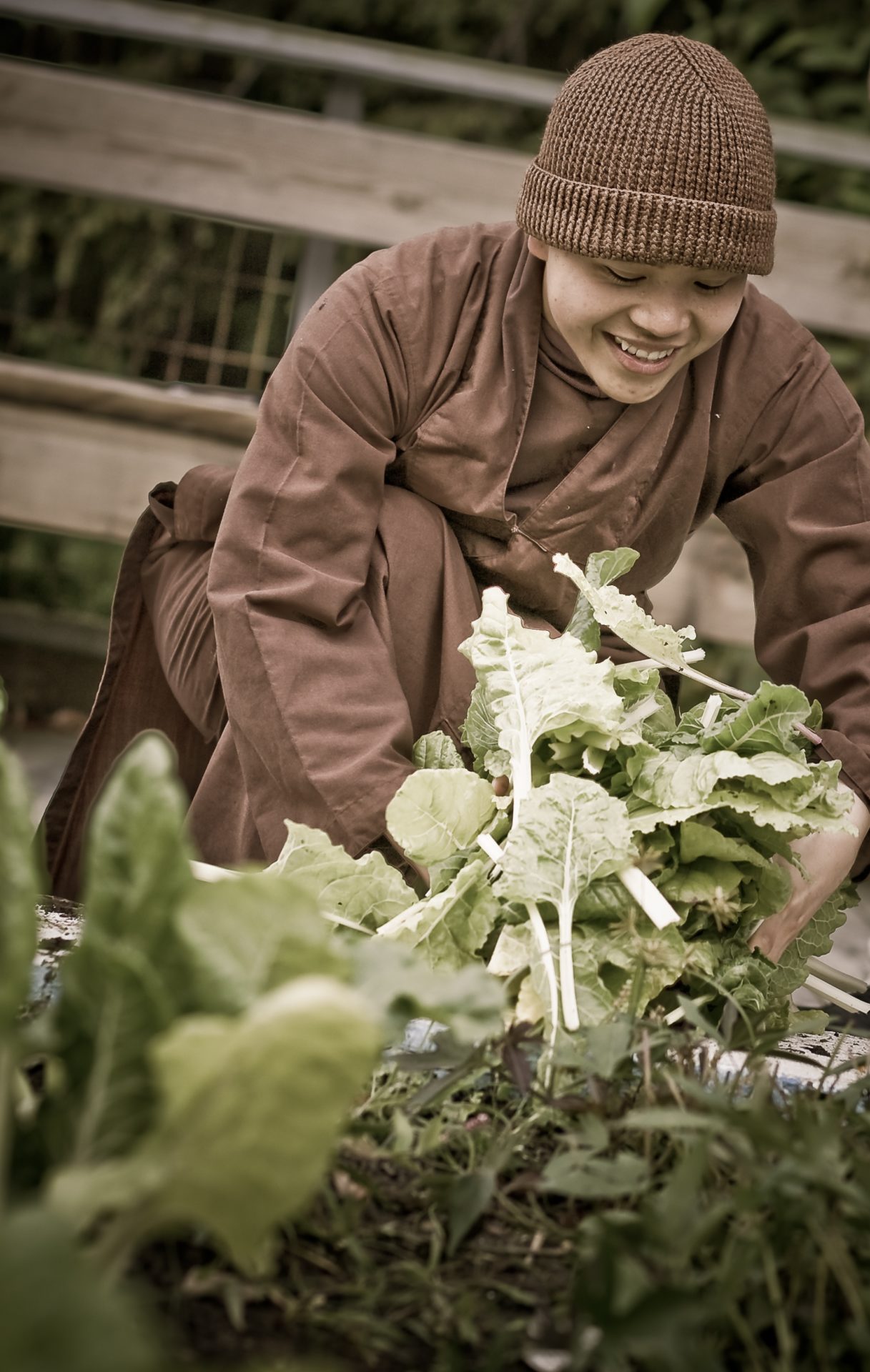By Julia Riley
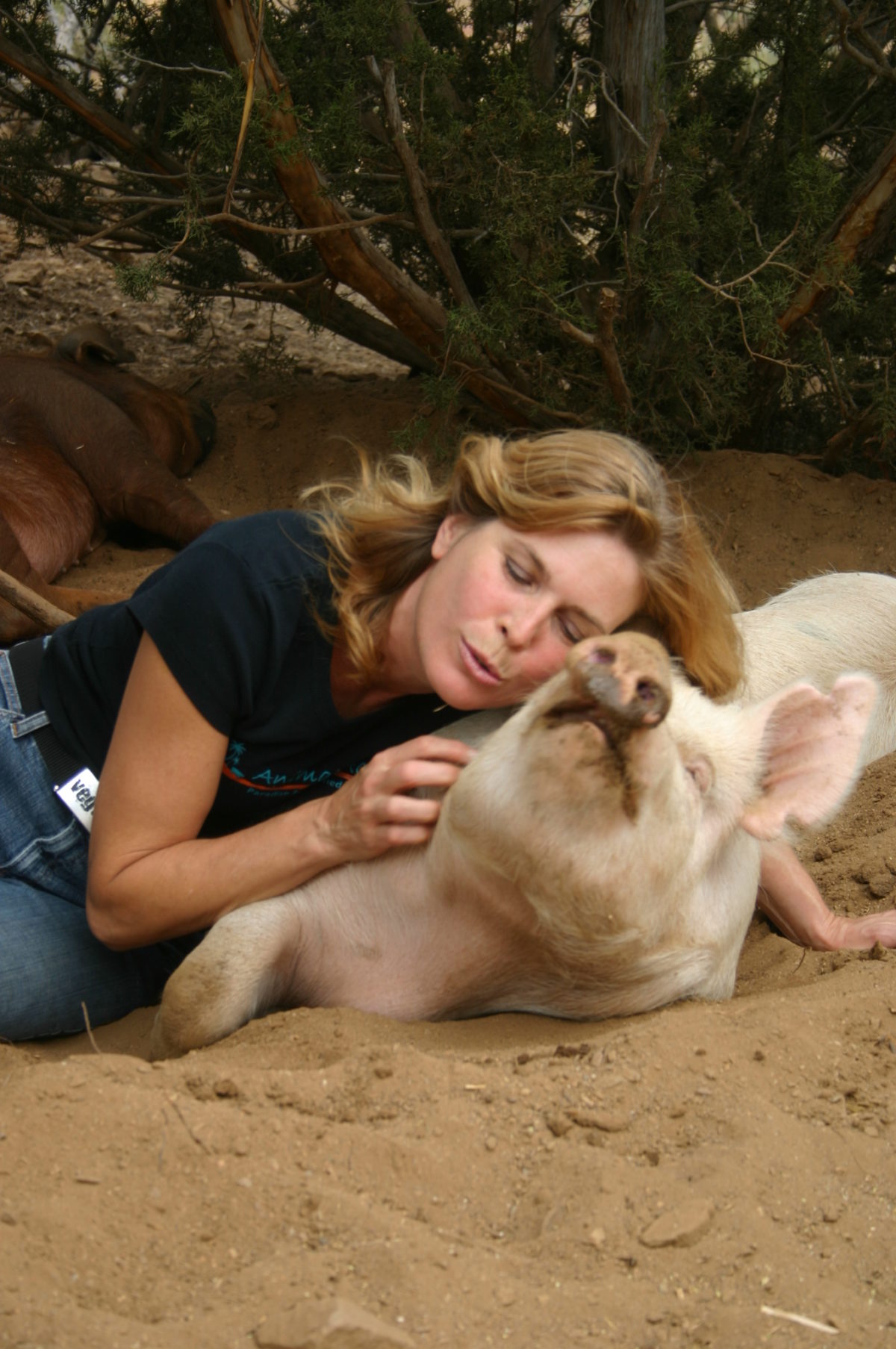
In 2010, I held a hen for the first time. I was attending an event at Animal Acres, a farmed animal sanctuary in Acton, California, when someone placed the little red bird in my arms. The hen felt so light, so delicate, and so warm. She settled in and started to doze, resting her head near my heart.
Animal Acres was founded in 2005 by Lorri Houston,
By Julia Riley

In 2010, I held a hen for the first time. I was attending an event at Animal Acres, a farmed animal sanctuary in Acton, California, when someone placed the little red bird in my arms. The hen felt so light, so delicate, and so warm. She settled in and started to doze, resting her head near my heart.
Animal Acres was founded in 2005 by Lorri Houston, True Tao Garden, who had cofounded Farm Sanctuary in Watkins Glen, New York, and Orland, California, in 1986.
As a child growing up in Wisconsin, Lorri felt deeply connected to animals and nature. She became vegetarian at age fifteen, became vegan in the mid 1980s, and turned her love of animals into a passion for working for animal protection.
“The thing I love most about farmed animal sanctuaries,” says Lorri, “is that they provide an opportunity to see farmed animals as beings. Each and every animal is an ambassador.”
One of Lorri’s most memorable encounters with such an ambassador happened when she met Henny, a chicken who had been used for egg production but who had escaped and stowed away on a New York City bus.
Henny came to live in Lorri’s home and insisted on snuggling in Lorri’s lap on the couch and sleeping on the bed, just as Lorri’s dogs and cats did. “This little being reminded me of all a chicken could be. She reminded me they really are no different from a dog or cat or you or me.”
“At a farmed animal sanctuary,” Lorri explains, “the animals have names, and people get to see their personalities. Farmed animal sanctuaries provide the connection that leads to people really rethinking food choices. It’s hard to think about eating a pig if you’ve just given one a belly rub.”
A pink piglet from East Palo Alto, California, helped inspire Kim Sturla to cofound the farmed animal sanctuary Animal Place, which has locations in Vacaville and Grass Valley, California.
An animal control officer brought the piglet, Zelda, to the humane society where Kim worked. The adoption staff got Zelda nestled in a dog kennel and tried to find her a home.
Only two potential adopters came forward, and both wanted to wait six months until Zelda weighed 250 pounds and then slaughter her.
The staff continued to search for adopters who would keep Zelda alive. At the same time, however, the humane society had a barbecue. Kim, who was then the only vegan or vegetarian at the humane society, saw the disconnect.
“This pig had value, and the staff wanted to protect her, but they were eating her sister. I realized that 98.5% of land animals killed in the United States are those that people eat. I saw what education and rescue were needed.”
Kim brought Zelda home, and Zelda became the first resident of Animal Place when the sanctuary was incorporated in 1989. Kim says Animal Place is “about kindness and compassion for all life—humans, too.”
Dharma teacher John Salerno-White, True Peace on Earth, describes Animal Place as “a safe space where animals are cared for and supported by humans,” and also as “a teaching location where people have a chance to learn and have physical contact and proximity with animals.” He adds that the sanctuary’s mission “is all compassion based and ties in with Thich Nhat Hanh’s teaching that compassion is a verb.”
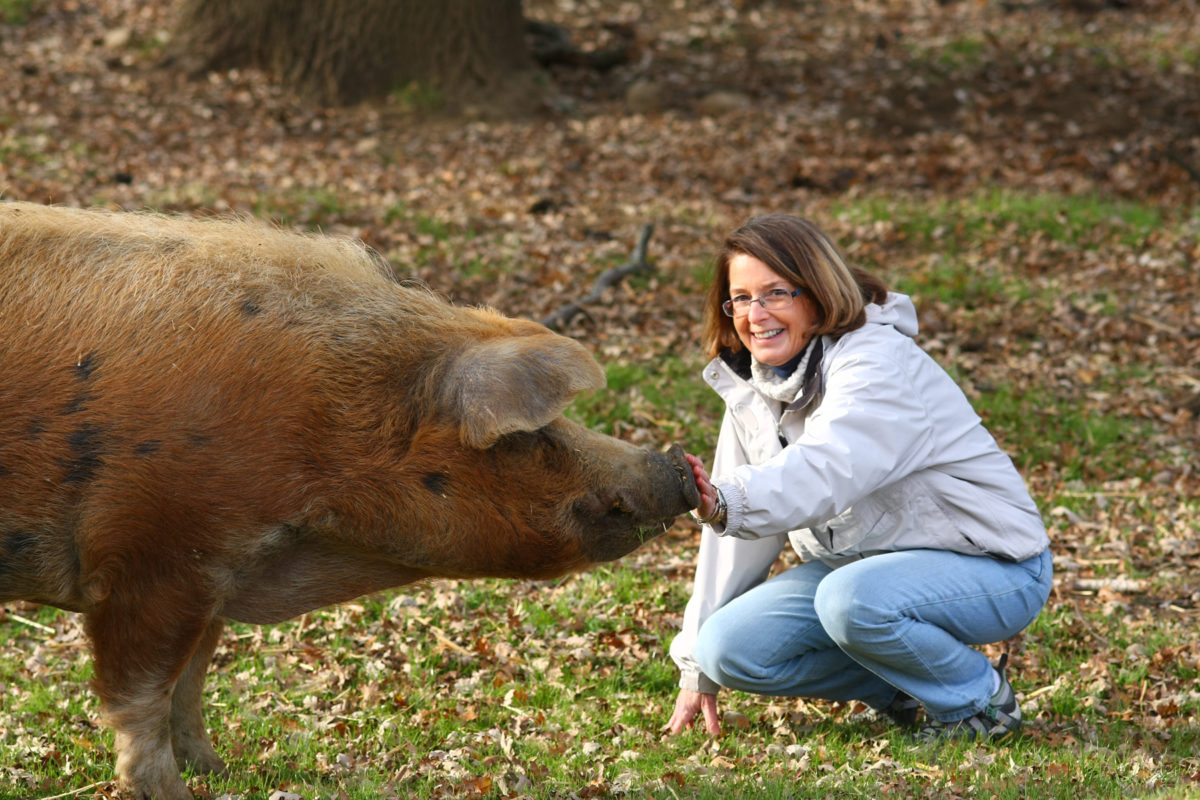
DAYS OF MINDFULNESS
In 2011, Kim cofounded Dharma Voices for Animals with “like-minded folks who felt that nonhuman animals were not having the voices they should” in practice communities and at practice centers.
In 2013, Kim and John, with the support of Dharma Voices for Animals, hosted a Day of Mindfulness at Animal Place to help people make contact with animals in a meditative setting, deepen understanding, and nurture compassion.
The Day of Mindfulness began with sitting meditation, followed by walking meditation to the areas where the animals were located. At each area, Kim spoke about the conditions in which the respective kinds of animals were raised.
She shared information about farming practices to which animals are subjected, including confinement, selective breeding (which brings about challenges such as rapid and excessive weight gain that impairs animals’ ability to support their own body weight), and the egg industry’s destruction of male chicks (which takes place even in organic and free-range egg production).
Participants had the opportunity to be present with the animals, seeing them and touching them while learning about their lives. John decided to “let the animals be the Dharma teachers,” because he thought they would “offer a better lesson than I could possibly offer about non-separation between humans and what we call animals.”
After visiting the animal areas, participants had a mindful vegan meal and some time to share reflections.
Because of positive responses from participants, several more Days of Mindfulness have been held at Animal Place during the years since.
John recalls some particularly moving interactions he has had at Animal Place. One time, he made prolonged eye contact with one of the pigs. “We just looked at each other. It was one of those experiences that had no words, but I had a feeling for a pig that I won’t forget. It was like the Buddha holding up a flower. I got the lesson. It was an immediate transmission. Fascinating.”
Another time, while petting cows, John saw a cow he had never seen before. “He was large, with beautiful horns. What is the word for this animal? Majestic! I was in awe of this animal’s being. I had memories of my prior life, of when I would have consumed the flesh of this creature. I will never go back to that. It has no appeal, the idea that I, or anyone close to me, would consider killing this beautiful being and eating his flesh.” Looking at the cow, John thought, “How could anyone meet you and ever want to eat you?”
“Through this all,” John reflects, “there’s some feeling of beneficial regret. I have ancestors who were cattle people. I myself did a lot of fishing. I need to do something about this, because I look at those prior behaviors, and there’s a little bit of horror. I need to do something to make it better. There’s some feeling that we have committed a wrong, and we realize we can’t undo it, but we set out to do some good based upon the wisdom we gained from our errors. I have apologized to the animals as well. Maybe that’s what I was doing with the pig—saying, ‘Sorry!’”
“If we can help humans to better care for nonhuman beings,” John adds, “it will help them to better care for human beings. If a human can have meaningful contact with a farmed animal, who is a member of another species, and who can’t talk, any feeling of separation among humans diminishes greatly. It’s another avenue toward equanimity.”
Rescue and Liberation
Both Lorri and Kim have engaged in many farmed animal rescues, from small-scale rescues of one animal to large-scale rescues of thousands.
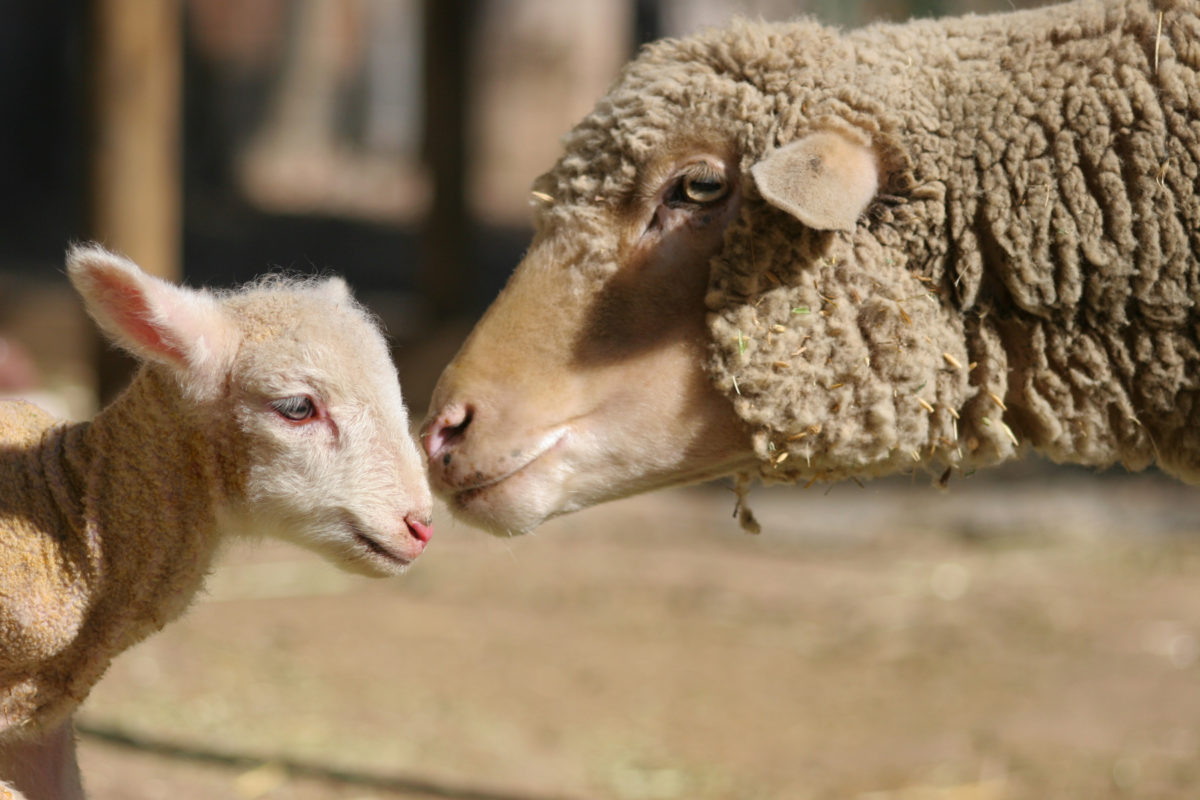
Lorri recalls the day she found a living sheep, Hilda, discarded on a pile of dead animals at a stockyard. “I didn’t expect such absolute disregard for animals as sentient beings. They are looked at as commodities, not as living beings capable of suffering. And this is the standard. The entire system is cruel.”
She also recalls the week she helped pull thousands of hens from Buckeye Egg Farm in Ohio in 2000, after a tornado left about a million chickens trapped in damaged battery cages with no access to food or water. “When rescuing animals from such a horrific situation, I’m connecting with loving kindness and compassion pouring from every inch of my being, and this brings great joy and happiness. I’m also connecting with many animals we aren’t able to rescue, and this brings great sorrow and sadness.”
“That’s why we need a path,” says Lorri, who started practicing in the Plum Village tradition in 2004, and who was ordained into the Order of Interbeing in 2013. “My aspiration was to smile again. The smile had left my soul. Thich Nhat Hanh brought it back.”
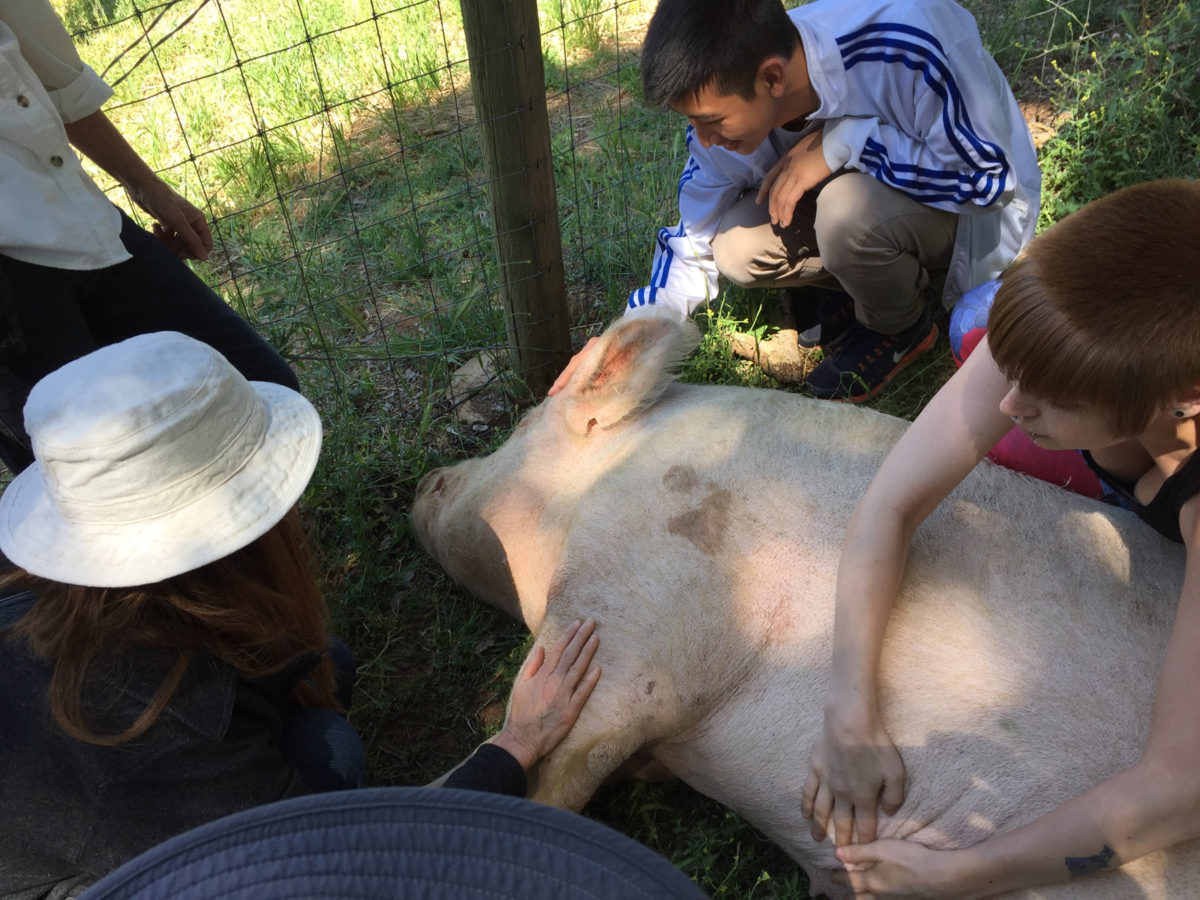
“Thay embodies the teaching and the practice to cause no harm, and he encourages compassionate action. He has always been not only an amazing teacher but also an amazing activist—an engaged Buddhist. I am ever so grateful. And when we truly do work from the heart,” Lorri adds, “beautiful things happen. People’s hearts are opening to the plight of animals used for food.”
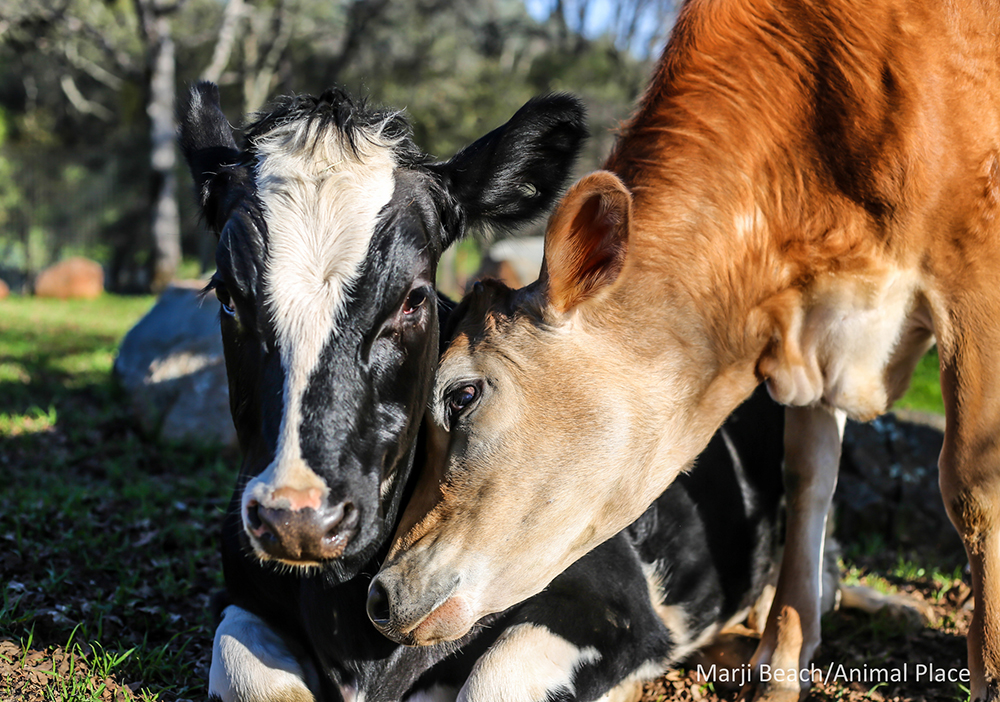
Kim tells of a woman who decided to help a starving pig she spotted at a farm on her way to work. Thanks to the woman’s concern and tenacity, the emaciated pig made it to Animal Place. Kim called him Bruce. “I just fed him and let him get his bearings and get satiated. He didn’t trust people. Each animal has an individual story and unique quirks. They’re just wonderful beings, like all life.”
Another case involved 50,000 hens abandoned and left to starve for more than two weeks at a factory farm in Turlock, California, in 2012. Sanctuary staff and volunteers saved as many birds as possible. The rescue was chronicled in Turlock: The Documentary, a film made by Keegan Kuhn, who later codirected the documentaries Cowspiracy: The Sustainability Secret (about the environmental impacts of animal agriculture) and What the Health (about the health impacts of animal foods).
Kim points out that the egg industry’s widespread practice of forced molting, in which hens are deliberately deprived of food, is not much different from what happened in the Turlock case. “For the hens in Turlock, it was just a little worse for a short time. It showed people what life is like for animals raised for food production.”
“In the Order of Interbeing,” John says, “we are called upon not to turn away from suffering—our own and others’. And this is one area where there are perhaps societal encouragements not to look deeply at others. Yet there they are. These sanctuary workers maintain compassion in the midst of hell realms. Their example encourages my practice to go into challenging situations with compassion and equanimity.”
“Doing everything I can seven days a week to minimize suffering,” Kim says, “feeds my soul and is my perhaps less formal practice. I can’t just sit with that suffering. I feel I’ve had a very blessed life, and with that blessed life comes enormous responsibility to improve the lives of others. My peace comes from going on the rescue. If I can be pulling the birds out one at a time from cages full of feces, I am not only saving the birds but also saving myself.”
“The workers on the rescues literally have to wade through the mire to find the happiness,” John reflects. “They encounter the transformation of the farmed animals they rescue, and through the liberation of the animals, they seem to get more in touch with their own liberation and that of other humans. A chicken’s first time touching the earth, coming out of a cage, is like a Dharma door to the world. These beings didn’t know they were chickens, because they never had the opportunity to be a chicken. I can see that with humans as well: ‘Oh, I’m a human being? I have a right to be happy and free from injury?’ ‘Yes, you do!’ It’s like someone who is helping someone make various stages of full contact with the Dharma.”
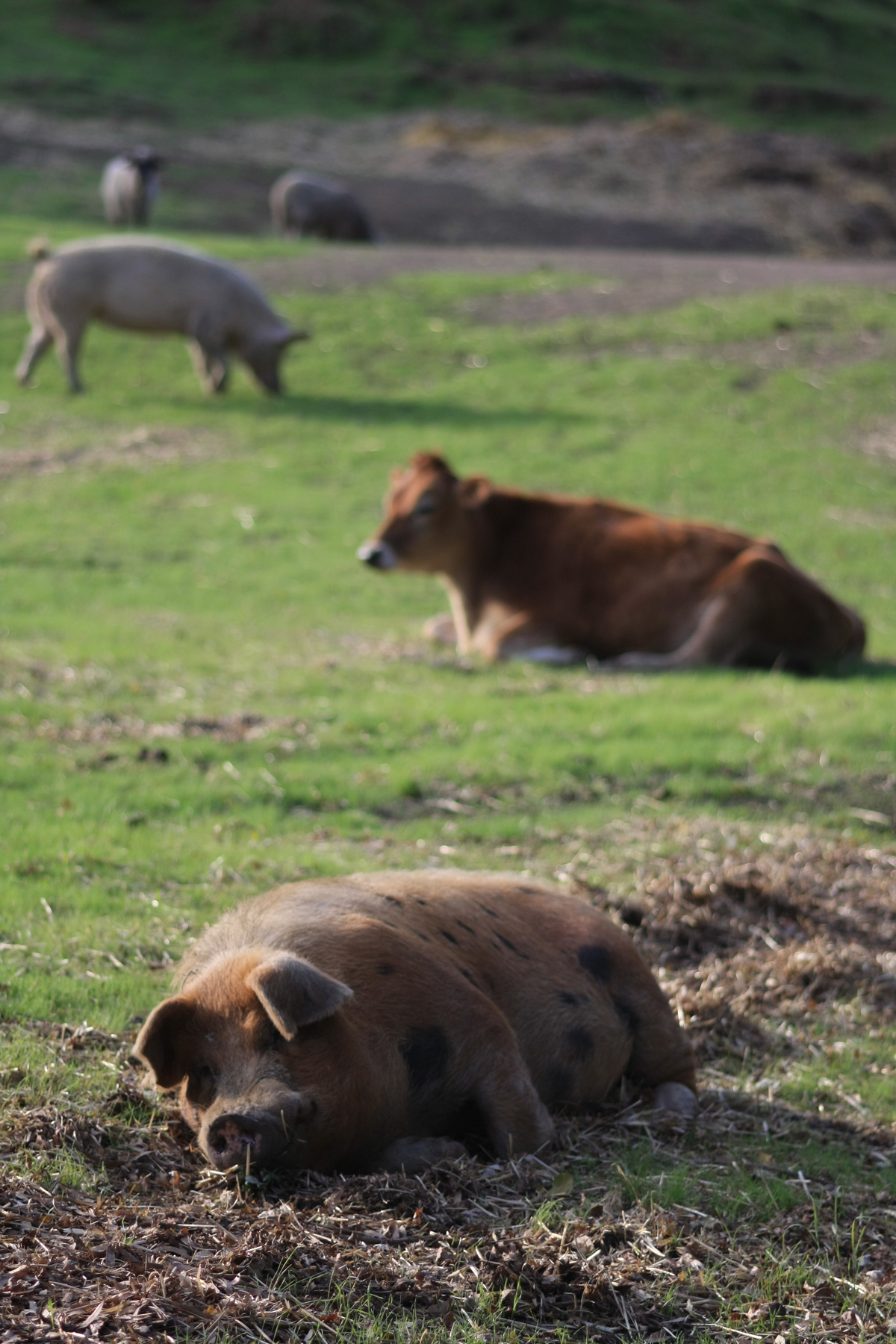
“People at a sanctuary can take solace in how the animals are non-judgmental and in how serene the sanctuary is,” Kim reflects. “People say, ‘This is my sanctuary too.’ I think it’s wonderful that we are filling that need for people too. There’s so much suffering in the world, and trying to alleviate any suffering is good.”
“What the animals at sanctuaries experience,” Lorri says, “is to trust again that not all humans are cruel and not all touch hurts. Anyone who receives as much love as the animals do at sanctuaries blossoms. The animals can’t say it in our language, but they say it with their bodies and their eyes.”
Lorri likens such giving and receiving of love to a line from the gatha for holding the alms bowl: “Giver, receiver, and gift held in perfect oneness.”
Julia Riley, Joyous Awakening of the Heart, is a writer, a vegan, and a person who works for peace, human rights, animal protection, and environmental sustainability. She practices with Hummingbird Sangha in Orange County, California, and with the Earth Holder Sangha. She is an Order of Interbeing aspirant.
QUESTIONS AND ANSWERS
For you, what are the joys of a mindful, plant-based diet?
John Salerno-White: Freedom and joy to take a non-vegan recipe and figure out how to veganize it. And being able to look a pig in the face, look at a chicken, look at a cow, and not have to say, “I’m sorry!” anymore, for my own part.
Kim Sturla: Not causing harm to other beings. Plain and simple.
Lorri Houston: Knowing I am not causing harm to another living being is one of the most joyful experiences, and Buddhism is helping me connect with that joy. There is no better feeling. A vegan saves hundreds of lives each year.
What would you say to someone who would like to make this transition, or who is new to this way of eating?
John: Get together with someone who knows how to cook a plant-based diet, and learn from them. Also, online recipes are huge.
Lorri: Go visit a farmed animal sanctuary. Spend some time cuddling cows, holding hens, and giving pigs belly rubs. That’s going to be the inspiration you need to transition. No one likes change. It’s challenging. But we can make impermanence our friend. Connect with Meetup groups and vegetarian groups. Learn more, meet others, and connect with the joy of knowing you’re not causing harm, in yourself and with others who feel the same. There are lots of easy recipes on Google. It’s pretty easy nowadays.
Kim: Just do it. It’s too easy. There’s an array of produce, whole grains, vegan cheese, margarine, and faux meat. The more challenging thing is: what else can you do in your life to reduce harm?
In addition to eating a plant-based diet, what are some other ways people can help farmed animals?
John: Considering their clothing, and considering whether their health and beauty products are tested on animals—they’re not farmed animals, but I wouldn’t make a distinction between the ways they are treated.
Kim: Helping others not eat animals. Cooking for people. Making delicious vegan cupcakes and chocolate tofu pie. There is so much all day long that we can all do to reduce suffering, and if you can, then why wouldn’t you? It feels really good to save a life. It’s the best feeling in the world. It gets no better.
Lorri: Offer to do mindful eating classes. Approach Sanghas in mindful, loving, and compassionate ways if they are eating animals. Be mentors. When people are interested, take the time to help. We all need guidance and support along the path. This is a path as well. We as practitioners need to guide and support.
RESOURCES
Dharma Voices for Animals: Bringing Awareness to the Suffering of Animals. http://dharmavoicesforanimals.org/
Sanctuaries.org: Your One-Stop Destination for Finding Farmed Animal Sanctuaries Near You! http://www.sanctuaries.org/

